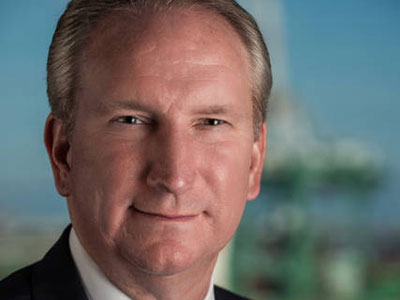In his “2022 State of the Port of Los Angeles” Executive Director Gene Seroka announced the Port processed about 10.7 million TEUs during 2021 which was 13% higher than its previous record.
California Governor Gavin Newsom also spoke and noted the proposed $2.3 billion in the California budget for ports “will make our ports and supply chain more efficient.”
As of January 20th, the Port of Los Angeles reported that 103 vessels are enroute to the Port. There are 8 vessels within 40 nautical miles of the Port waiting to unload and an additional 95 vessels drifting or slow steaming toward the Port. For vessels within 40 nautical miles, the average wait to berth a vessel is 4.5 days.
Seroka also paid tribute to the International Longshore and Warehouse Union (ILWU) workforce and several were featured in a video segment, including ILWU Local 13 President Ramon Ponce de Leon, who recalled the challenges faced by workers loading and unloading containers during the COVID pandemic. The virus has caused the deaths of 11 longshoremen.
Seroka said, “the bipartisan Infrastructure and Jobs Act contains $17 billion for ports and inland waterways” He also applauded Governor Gavin Newsom’s proposing $2.3 billion dollars for California ports in the state budget.
He noted: This money will fund a futures-ready goods movement workforce. This is also an opportunity to correct an historic funding imbalance. Over the past decade, East Coast and Gulf Coast ports have received 11 times more federal investment then we have on the West Coast. That must change with these new sources of funding.”
Seroka said that in the Fourth Quarter of 2021, “the growing number of import containers not being picked up from our terminals caused us to announce our intention to adopt and implement an excess dwell fee on loaded boxes sitting 9 days or more. Merely announcing the fee, reduced the amount of idling containers by more than 60% and so we have not implemented the fee.”
However, the Port has become increasingly concerned about empty containers that have not been picked up by ocean carriers: “Because we are starting to see a buildup of empty export containers on our terminals, we’re discussing a similar fee with our Board and incentives that encourage repositioning of outbound empties in support of U.S. exporters.“

In other news, Seroka announced:
Negative Impact of Trucks in Neighborhoods
Seroka said that there has been a growing problem of harbor trucks idling in neighborhood streets and blocking driveways near the Port. Los Angeles Councilman Joe Buscaino, who represents constituents in the San Pedro and Wilmington areas contingent to the Port, said that more attention needs to be paid to the negative impact of truck and ship pollution on neighbors as well as truck traffic spilling over into neighborhoods as a result of traffic jams at Port terminals. Seroka said there has been a stepped-up response by law enforcement to clear neighborhood streets of trucks.
Digitization Improves Efficiency
In 2021, the Port unveiled the Control Tower suite of data tools, expanding the Port Optimizer system developed by the Port in conjunction with Wabtec. The Control Tower aids cargo owners and service providers by delivering precise shipping intelligence and real-time insights on Port of Los Angeles cargo. In 2022, the Port will add further enhancements to the Port Optimizer and work with the Biden Administration to support a national Port data initiative to improve supply chain efficiency and global competitiveness.
Cybersecurity
Seroka said: “Now more than ever we need to protect our digital systems from cyber-attacks.” The first port cyber defense system co-developed with IBM is now in full operation. This new Cyber Resilience Center serves as an early warning system and information sharing network for Port stakeholders.
Human Resources
Younger workers are vital to replace older workers in supply chain-related companies and younger people can find jobs in the warehouse and trucking industries. The Port continues to support high school and community college programs that train and educate younger people to be tech savvy participants in logistics and transportation. Seroka cited the role of the non-profit organization EXP that has supported logistics and port-oriented job training for students in local high schools. The Port’s planned Goods Movement Training Campus will focus on worker skill development and received a huge boost this month with a three-year $110 million commitment from California Gov. Newsom in his proposed budget. The first in the U.S. specifically dedicated to the goods movement industry, the campus will also serve as a state resource for training workers on greener and zero-emission technologies. Further plans for the Training Campus will be announced later this year.
Zero-Emission Operations
Ocean carriers are ordering new ships utilizing cleaner fuels than traditional bunker fuel. These fuels include LNG and other alternative fuels: “A green ports corridor will be established between the Port of Los Angeles and a port in Asia.” he said. He also noted: “We are now testing 107 zero emission and 27 near zero emission units in areas of cargo handling and drayage. That number will exceed 200 units in the next 18 months. In 2022, a half a dozen manufacturers including major global brands will deploy next generation drayage trucks in and around our Port complex.” Seroka also announced that in April the Port will begin collecting the Clean Truck Fund Rate, which is expected to raise $130 million over the next three years. Those funds will be used to fund zero-emission trucks and fueling infrastructure development.
Cruise Ships
Seroka welcomed the return of cruise ships to the Port after a COVID imposed absence. He expects 200 cruise ship sailings in 2022.

